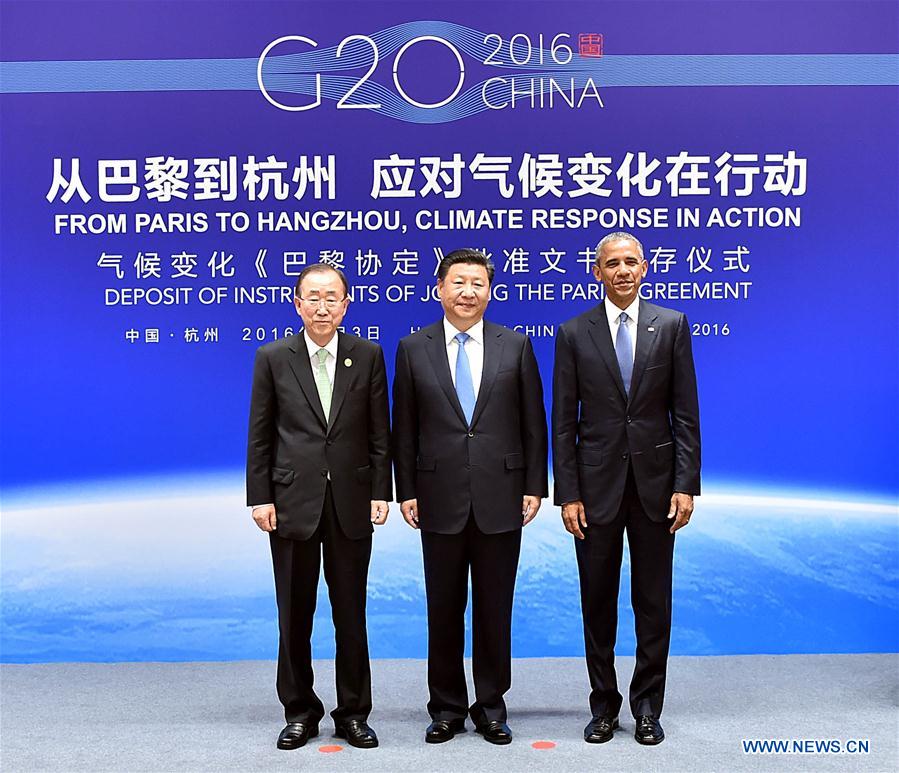 Earlier this month, China hosted the leaders of the G20 countries for their annual summit. International summits have traditionally played an important role in diplomacy. On the one hand, summits hold ceremonial or dramatic importance as they demonstrate one of diplomacy’s function in international relations- ensuring stability and peace. On the other hand, summits also play a functional role as they enable decision makers to directly interact with one another in order to find shared solutions to shared challenges.
Earlier this month, China hosted the leaders of the G20 countries for their annual summit. International summits have traditionally played an important role in diplomacy. On the one hand, summits hold ceremonial or dramatic importance as they demonstrate one of diplomacy’s function in international relations- ensuring stability and peace. On the other hand, summits also play a functional role as they enable decision makers to directly interact with one another in order to find shared solutions to shared challenges.
Summits such as the latest G20 also demonstrate the manner in which diplomacy has changed during the 20th century. Indeed in previous centuries, regional summits were a rarity. When they did occur, they were usually attended by diplomats rather than heads of state. Such was the case with the Vienna conference of 1814 in which Ambassadors of European nations came together to establish a new post-war order. During such summits, Ambassadors were still extraordinary and plenipotentiary meaning that they were authorized to negotiate and sign treaties on behalf of their states.
Yet the 20th century saw a shift in summitry diplomacy as these were now attended by world leaders. Consequently, leaders needed to learn the crafts of multi-lateral diplomacy, negotiation and relationship building.
The 21st century has seen another stage in the evolution of diplomacy given the utilization of digital tools to achieve foreign policy goals. The latest G20 summit in China best exemplified the manner in which digital tools are employed by countries during international summits.
The Presentation of the State in Everyday Life
The utilization of digital diplomacy tools by China was mostly limited to a website and an SNS account.
In August of 2016 the Chinese government launched the @G20_China twitter channel. Over the course of the summit, the channel was updated regularly by the Chinese government. Yet an analysis of the content published online suggests that the vast majority of tweets included images from meetings between world leaders and the occasional ceremonial handshake, as can be seen in the tweets below.
Xi urges China, Britain to deepen mutual trust, cooperation pic.twitter.com/P047S7ZLBG
— G20china (@G20_China) September 6, 2016
China always values #France as important strategic partner, Xi says. pic.twitter.com/uG7HdJZqJs
— G20china (@G20_China) September 6, 2016
Additionally, some tweets were meant to offer SNS followers access to the “backstage” of multi-lateral diplomacy. However, such tweets were also comprised of carefully selected images that merely gave the appearance of the backstage while actually still portraying events from the stage of the summit.
Finally, a substantial portion of Chinese tweets were used to brand the host country. Indeed hosting international summits offers a unique branding opportunity as global attention focuses on one nation. For China, this was another occasion to brand itself as a rising power. Even more importantly, the summit could be incorporated into the Chinese narrative of a rising Soft Power, one dedicated to achieving goals through diplomacy, culture and trade rather than military force.
The three tweets below demonstrate China’s Soft Power branding during the G20. The first tweet highlights China’s global stature given the President’s hosting of world leaders; the second tweet highlights China’s Soft Power doctrine as it focuses on collaborative scientific projects and the third corresponds with its image as a global financial powerhouse.
#G20 in China, a new launchpad for global economy pic.twitter.com/2FK7TFoe8k
— G20china (@G20_China) September 6, 2016
Welcome to Hangzhou, the capital of east China’s Zhejiang Province, where the #G20 Summit is held. pic.twitter.com/eYdUvMRpal
— G20china (@G20_China) September 4, 2016
In summary, the Chinese government used digital diplomacy to enhance the dramatic effect of international summits. The stage of diplomacy was simply extended to digital platforms. SNS followers could not gain access to the backstage nor learn anything substantive about the deliberations tacking place between world leaders. This was but one more element in the online presentation of the state in everyday life.
How Digital Tools could have Been Employed
International summits often lead to a peak in online activity pertaining to an issue of great importance (e.g., climate change). Moreover, during such summits national, regional and global networks all collaborate online in order to promote ideas, policy recommendations and solutions to mutual challenges. Lastly, it is during summits that such networks are most active as they attempt to exert influence on diplomatic negotiations. China could have utilized this online flurry of activity in order to re-define how digital tools are used during summits. Below are three examples of such utilization.
1. Dialogue between the host country and online publics– Global summits attract global attention as networked individuals congress online in order to learn about events shaping their world. China could have utilized digital tools in order to converse with such online publics. For instance, the Chinese government could have queried publics in order to identify issues of great concern. These issues could have then been added to the summit agenda. Moreover, the Chinese government could have held online QA sessions between its leaders and online publics in order to explain the importance of the issues being discussed at the summit. Such interaction may have also enabled China to narrate its global policy objectives and address public criticism of its existing policies (e.g., Human Rights). Lastly, the Chinese government could have invited SNS users to collaborate in the creation of a social media campaign that would address one important issue being discussed at the summit.
While Chinese leaders may be unaccustomed to dialogue and criticism, online interactions with SNS users would have served as a more powerful branding tool than any one image. In fact, such conversations would have demonstrated China’s commitment to forging new relations with other countries while also transitioning towards more open and transparent forms of government. In addition, online interactions would have helped China forge relationships with global audiences thus facilitating the acceptance of Chinese foreign policy around the world. Online interactions would have also offered the Chinese government an opportunity to demonstrate de facto its “Soft Powerness” which relies on dialogue rather than confrontation.
2. The Leaders’ Forum- China could have also utilized digital platforms in order to enable online publics to converse with the leaders assembled at the summit. For instance, China could have organized a Leaders’ Forum in which leaders would address questions posed by SNS users. In addition, SNS users could have been asked to suggest issues that would then be debated between global leaders in an open forum. Such a Leader’s Forum would have enabled global citizens to directly interact with their leaders and possibly influence the global agenda.
3. Networking Opportunities– Scholars have suggested that networks excel at finding innovative solutions to global challenges. The Chinese government could have mapped online networks that were relevant to the G20 agenda. Next, the government could have presented each network with a challenge that would be addressed during the summit. These networks could have then been invited to present world leaders with innovative solutions to the aforementioned challenges. By so doing, China could have harnessed digital platforms’ potential to stimulate debate and crowdsource solutions to wicked problems.
Branding the G20
The potential use of digital platforms suggested in the previous section would have impacted China’s global brand. Yet even more importantly, such online conversations would have proved useful for the promotion of the G20 brand in its entirety. The G20 leaders that assembled in China all head national governments that are accountable to their citizens. In the digital age, citizens expect their governments to be more open and transparent in their dealings at home and abroad. Traditionally, governments have resisted such transparency given a risk averse culture and an institutional mentality that favours information keeping rather than sharing. Yet by conversing with online publics, inviting publics to partake in setting the summit agenda and offering publics the opportunity to influence the debates at the summit, China could have branded the G20 as an open and transparent organization- one befitting the 21st century.







